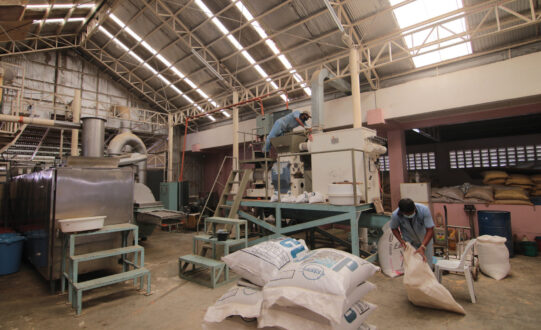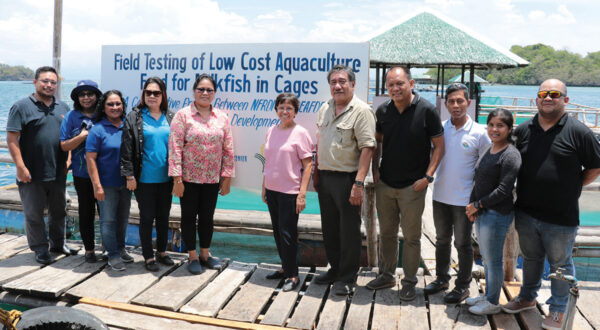
THE PROBLEM
Feeds account for over 50% of the cost of production in aquaculture
Formulated feeds account for the single largest expense in aqua-culture production runs, responsible for over 50% of the cost. This is largely due to fish-derived meals and oils which take up to 40% of the feeds, especially in those formulated for carnivorous species. However, these ingredients come at a high cost both to the farmers and to the environment. Reducing the amount of fish-based ingredients in feed formulations by using non-fish alternatives will significantly benefit the aquaculture industry.
Relying less on fishmeal and fish oils will lower feed prices and improve the profitability of fish farms. This will also benefit the environment by reducing the pressure on wild fish in the oceans which are the source of these fish-based ingredients.
SOLUTIONS
- Find cheaper alternatives to substitute for fish-based feed ingredients
- Come up with effective feed formulations using the cheaper alternative ingredients
- Promote locally-sourced alternative ingredients to bring down cost
ECONOMIC VALUE
- Over 1 million tons of commercial aquaculture feeds were consumed in the Philippines in 20161
- Feed cost may be reduced by up to 44% based on initial trial runs by SEAFDEC/AQD
1Mamauag, RE. 2017. Status of aquaculture feed and feed ingredient production and utilisation in Philippines. Network of Aquaculture Centres in Asia-Pacific. https://enaca.org/?id=907
What has SEAFDEC/AQD been doing? (2018-2020)
Search for alternative ingredients
In recent years, SEAFDEC/AQD has been testing agro-industrial wastes and byproducts (mango peel silage, soybean curd residues, citrus by-products) for suitability as protein source for tilapia breeders and fingerlings. Protein-enhanced copra meal was also analyzed and tested as protein source for grouper (Epinephelus coioides). A hydrolysate of milkfish by-products, with its rich protein content, was also evaluated as a potential feed ingredient for pompano (Trachinotus blochii) and tilapia diets.
Promising results were obtained from distillers dried grain solubles (DDGS), a by-product of the distillery industry, which was shown to significantly improve milkfish growth.

Public database for alternative ingredients
The Regional Database of Alternative Feed Ingredients in Aquaculture was officially launched by SEAFDEC/AQD in July 2018. The database, accessible at http://afid.seafdec.org.ph, is intended to serve as a reference on the different feed ingredients that, depending on cost and availability, may be used to produce cheaper feed. Alternative feed ingredients include leguminous seed meals, leaf meals of various terrestrial plants such as ipil-ipil, papaya, and cassava as well as non-conventional sources like snails and worms.
The database currently lists 70 different feed ingredients along with their nutritional composition and optimal inclusion levels.
Low-cost formulations
The average cost of a commercial feed is between Php 34 to 36 per kg which is higher compared to the SEAFDEC/AQD formulated diet which costs around Php 19 to 22 per kg. When produced in a commercial scale, the cost of the SEAFDEC/AQD feed could even be lower.
Testing of feed formulations
Initial growth trials for milkfish were conducted at the Igang Marine Station in floating net cages last June 2019. SEAFDEC/AQD formulated feeds were tested against commercial diets. After 120 days of culture, milkfish fed with the SEAFDEC/AQD diet achieved a total of 2,795.30 kg of harvest which is higher than that of milkfish fed with commercial feed which achieved 2,234.92 kg of harvest. Milkfish fed with the new diet also weighed more (393.45 g average) than commercial diet-fed milkfish (325.35 g). Feed conversion ratio was 2.10 and 2.43, respectively.
In partnership with NFRDI Muñoz, a similar feeding experiment for tilapia was initiated at Muñoz, Nueva Ecija last 27 June 2019. A second feeding experiment for tilapia was conducted at Lala, Lanao del Norte on September 17, 2019. In the latter, after 120 days of culture, the experiments harvested a total of 1,097.93 kg from ponds fed with the SEAFDEC/AQD diet and 1,023.50 kg from ponds fed the commercial diet with an average body weight of 338.45 and 308.28, respectively. Feed conversion ratio was 1.35 for the SEAFDEC/AQD diet and 1.52 for commercial feeds.
|
Project to lower cost of aquafeeds kicks off in Guimaras 
A new feed formulation that hopes to lower the cost of fish farming and make fish more affordable to the masses kicked off with the field-testing of the low-cost feed at the Igang Marine Station of last 15 May 2019. The new formulation, developed by scientist Dr. Roger Edward Mamauag, uses cheaper alternative ingredients and will also be tested around the country in partnership with the National Fisheries Research and Development Institute (NFRDI) and the Bureau of Fisheries and Aquatic Resources (BFAR) . Dr. Mamauag said that the feed cost can still go down if the feed is produced in a commercial scale. However, the positive research result still needs to be verified through field testing. He explained that the field testing of the feed in Guimaras is for milkfish reared in sea cages. This feed will also be tested in milkfish sea cages located in La Union and Eastern Samar. He also said that there will also be a field testing of low-cost aquaculture feed for tilapia in Nueva Ecija, Lanao del Norte, and Batangas. Moreover, according to Maria Theresa Mutia, chief aquaculturist of NFRDI, commercial adoptors will be tapped for the validation of the verification trials on the third year of this three-year project. Drusila Esther Bayate, NFRDI interim executive director and BFAR assistant director for technical services, said that she hopes the project will be a success. “I foresee it will be because of its practicality and it’s really a very good technology,” said Bayate. |
 SEAFDEC/AQD Southeast Asian Fisheries Development Center | Aquaculture Department
SEAFDEC/AQD Southeast Asian Fisheries Development Center | Aquaculture Department